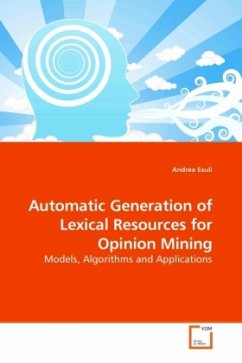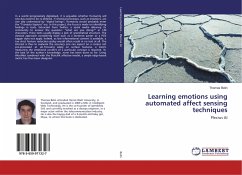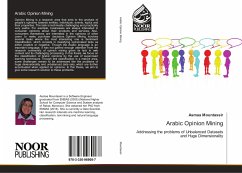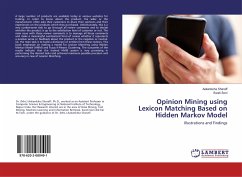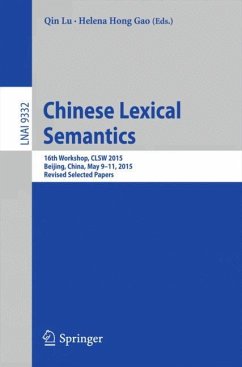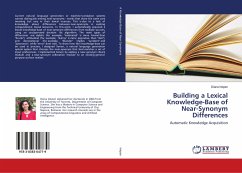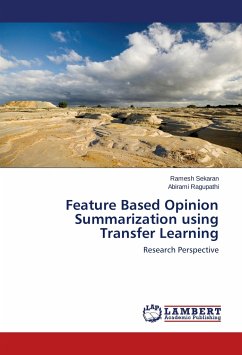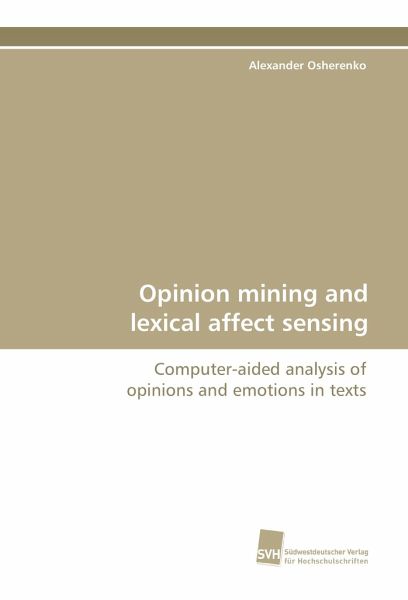
Alexander Osherenko
Broschiertes Buch
Opinion mining and lexical affect sensing
Computer-aided analysis of opinions and emotions in texts
Versandkostenfrei!
Versandfertig in 6-10 Tagen

PAYBACK Punkte
30 °P sammeln!





This dissertation describes an interdisciplinary study that considers linguistic and psychological findings to perform computer-aided categorization of opinions and emotions in texts. It discusses various emotional corpora (movie reviews, weblogs, product reviews, and natural-language dialogues) and describes different approaches to affect classification of their texts: a statistical approach that utilizes lexical, deictic, stylometric, and grammatical information; a semantic approach that relies on emotional dictionaries and on deep grammatical analysis; a hybrid approach that combines the st...
This dissertation describes an interdisciplinary study that considers linguistic and psychological findings to perform computer-aided categorization of opinions and emotions in texts. It discusses various emotional corpora (movie reviews, weblogs, product reviews, and natural-language dialogues) and describes different approaches to affect classification of their texts: a statistical approach that utilizes lexical, deictic, stylometric, and grammatical information; a semantic approach that relies on emotional dictionaries and on deep grammatical analysis; a hybrid approach that combines the statistical approach and the semantic approach. Furthermore, this thesis explores affect sensing using multimodal fusion that utilizes lexical and acoustic data. In conclusion, the thesis discusses significant contributions and describes future work.
Alexander Osherenko graduated from University of AppliedSciences, Hamburg with the B.Sc. degree in computer science. Heobtained his M. Sc. degree in computer science from HumboldtUniversity, Berlin and the PhD degree from University ofAugsburg, Germany.
Produktdetails
- Verlag: Südwestdeutscher Verlag für Hochschulschriften
- Seitenzahl: 276
- Erscheinungstermin: 30. Juni 2015
- Englisch
- Abmessung: 220mm x 150mm x 18mm
- Gewicht: 376g
- ISBN-13: 9783838124889
- ISBN-10: 383812488X
- Artikelnr.: 33263609
Herstellerkennzeichnung
Die Herstellerinformationen sind derzeit nicht verfügbar.
Reviewed by Marina Santini
The PhD thesis “Opinion mining and lexical affect sensing” by Alexander Osherenko contains nine chapters, six appendices and an index.
The thesis presents approaches to emotion recognition from texts belonging to several emotional corpora. Four approaches are experimented and discussed in detail, namely (1) the statistical approach based on data mining techniques; (2) the semantic approach leveraging on semantic features and grammatical interdependencies; (3) the hybrid approach that combines the statistical approach and the semantic approach; and finally (4) the multimodal-fusion that builds upon the linguistic modality and acoustic modality.
The importance of automatically detecting
The PhD thesis “Opinion mining and lexical affect sensing” by Alexander Osherenko contains nine chapters, six appendices and an index.
The thesis presents approaches to emotion recognition from texts belonging to several emotional corpora. Four approaches are experimented and discussed in detail, namely (1) the statistical approach based on data mining techniques; (2) the semantic approach leveraging on semantic features and grammatical interdependencies; (3) the hybrid approach that combines the statistical approach and the semantic approach; and finally (4) the multimodal-fusion that builds upon the linguistic modality and acoustic modality.
The importance of automatically detecting
Mehr anzeigen
emotions is motivated by the benefits that emotionally-intelligent technical artifacts would bring to humans (p. 4).
Chapter 1 – Introduction – presents the issue: how can computers detect emotions in texts? The author proceeds by showing an example of an emotional texts, namely the movie review genre. The main problems are: “First, analyzed texts can be very different in regard to the contained words” (p. 3); second, “particular words in an analyzed utterance influence the meaning of the text in different manner” (p. 3), for example negations and intensifiers; third, the emotional meaning is not always detectable from isolated words, but might come out from a text chunk, like in the sentence “I doubt he is happy” (p. 3). Motivations for pursuing a research in a well-studied and exploited field, such as emotion recognition in texts, are then listed (pp. 4-8). Since the basic different meanings among the words “emotion”, “affect”, and “opinion” in texts are difficult to explain and are not acknowledged unanimously, the authors proposes a “numeric” distinction between these notions. That is, if the analyzed text contains more than 200 words, it will be a matter of opinion and opinion mining; otherwise it will be a matter of affect sensing; if the length of the analyzed text is unknown, it will be a matter of emotions (p. 9). Chapter 1 ends with the list of the research questions that will be investigated and the thesis,
Chapter 2 – Affective Behaviour – contains an overview of detection, definitions and modeling of emotions, and focuses on psychological cues, linguistic cues, types of emotions, emotion dimensions and affect modeling. The PSI model and OCC model are introduced.
Chapter 3 – Related work on opinion mining/lexical affect sensing – describes the three levels of granularity that can be used to detect emotions, namely the word level, the sentence/phrase level and the document level. The chapter ends with a list of shortcomings of previous approaches.
Chapter 4 – Corpora – lists and describes the document collections that are used to evaluate the automatic approaches to emotion detection that the thesis presents in the following chapters. The collections are divided in those containing long texts (four corpora), and those including only short texts (two corpora).
Chapter 5 – Statistical Opinion Mining – tackles emotion recognition in terms of data mining and is based on statistical methods. This chapter discusses several types of features (namely, lexical, stylometric , deictic, and grammatical features), describes the main problems associated to data mining techniques, finally presents the classification results returned by the differing features using SMO (Weka’s implementation of SVM classifier). However, “[c]lassification results using lexical features as opposed to classification results with deictic, stylometric or grammatical features are maximal in all corpora” Classification results are encouraging (p. 138), however it is not transparent to a human why the count of shallow features with no semantic content are so discriminative” (p. 137).
The opacity of shallow features is addressed in Chapter 6 – Semantic Affect Sensing – where the author investigates the effectiveness of semantic features and grammatical interdependencies to see whether their transparency to humans is coupled with classification efficiency. The approach analyzes affect in short texts and results are encouraging, i.e. considerably higher than the baseline by chance (p. 167). The semantic approach has, however, two drawbacks: it is dependent on emotion words that are currently contained in a number of dictionary that are not complete or exhaustive (p. 168); additionally, it appears to be more corpus dependent since the context of use is linked to the corpus and not on a not on a more general context.
In Chapter 7 – Hybrid Emotion Recognition – the author explores the possibilities to achieve a better performance by combining the statistical approach and the semantic approach. The aim is the implementation of “an approach to emotion recognition that classifies affect fully automatically and does not need hand-crafted work still remaining plausible for a human” (p. 170). First, an approach for long texts is presented. The approach consists in splitting long texts in sentences, analyzing each sentence separately using the semantic method and finally creating datasets to be fed to SVM. Then the authors describes an hybrid approach for short texts in two variants. In the first variant, the statistical approach is chosen as leading and the semantic approach supplies additional features; the second variant, affect sensing is performed using a rule-based approach that utilizes results of the semantic approach and the statistical approach. The author argues that the small increase (less than 0.5%) of the hybrid approach is important, since the results of statistical approach and the semantic approach taken separately yield lower performance.
In the last experimental chapter, Chapter 9 – Affect Sensing Using Multimodal Fusion — an approach that combines the linguistic modality and acoustic modality. Results show that no additional improvement is yielded by fusing linguistic and acoustic features.
EVALUATION
The PhD thesis ” Opinion mining and lexical affect sensing ” is a valuable contribution to automatic emotion identification. It has a broad experimental scope since four main approaches with several variants are presented, discussed and assessed by the authors in terms of performance and potential. The author, Alexander Osherenko, has successfully capitalized on this research work by founding his own company, Socioware (http://socioware.de/).
However, I would warmly encourage the author to complement the findings of this research completed in 2010 in two ways:
1) Since results and experiments are dense of information, I would suggest creating a small website dedicated to the thesis (which has been published as a book) and add a comprehensive web-based table where the four approaches and their variants are compared in terms of: corpus, accuracy, precision, recall, f-measure and statistic significance. It is in my opinion an arbitrary decision to show only the recall (with few exceptions) of the classification results. The author says: “Since performed experiments did not reveal any significant difference in the recall and precision measures, figures below show only the recall and not the precision measure”. This decision makes results harder for the reader to assess the whole experimental picture and to reflect upon the pros and cons of the individual approaches.
2) I would also suggest creating a “live” chronological graph where the performance of the classification on emotional corpora is updated according to new experiments, performed by the authors or other researchers. Emotion detection is a hot and interest-gathering topic and what was promising a few years ago might be obsolete today.
Personally, I find the numeric definition of emotions in Chapter 1 quite dismissing, although I understand that it might be difficult to disentangle bordering concepts.
Being a genre researcher, I am glad that the author acknowledges the importance of genre for future work (p. 197). It was quite evident since page 2, when the author describes an example of the review genre, that the compositional structure brought about by genre differences could be used to improve results. Referring to Reelviews, 2008, the author says “[m]ovie reviews is a text consisting of the plot of the movie and the opinion of the reviewer” (p.2). This information has been neglected in the experiments. One way of proceeding would have been to extract the opinioned part of the review, usually at the bottom of the text, but not the narrative section (usually at the beginning of the text) and apply classification only on the emotionally denser text selection.
A peculiarity of the style is the extensive use of interrogative sentences to build the argumentation. Often, at the end of sections there are often interrogations that are answered in the following (sub)sections. For instance, “But why s computer-aided emotion recognition I texts so important? What is the motivations?” (p. 4). These are discussed and answered in the next section with title MOTIVATION.
In conclusion I would say that the thesis “Opinion mining and lexical affect sensing” is good food for thought.
Chapter 1 – Introduction – presents the issue: how can computers detect emotions in texts? The author proceeds by showing an example of an emotional texts, namely the movie review genre. The main problems are: “First, analyzed texts can be very different in regard to the contained words” (p. 3); second, “particular words in an analyzed utterance influence the meaning of the text in different manner” (p. 3), for example negations and intensifiers; third, the emotional meaning is not always detectable from isolated words, but might come out from a text chunk, like in the sentence “I doubt he is happy” (p. 3). Motivations for pursuing a research in a well-studied and exploited field, such as emotion recognition in texts, are then listed (pp. 4-8). Since the basic different meanings among the words “emotion”, “affect”, and “opinion” in texts are difficult to explain and are not acknowledged unanimously, the authors proposes a “numeric” distinction between these notions. That is, if the analyzed text contains more than 200 words, it will be a matter of opinion and opinion mining; otherwise it will be a matter of affect sensing; if the length of the analyzed text is unknown, it will be a matter of emotions (p. 9). Chapter 1 ends with the list of the research questions that will be investigated and the thesis,
Chapter 2 – Affective Behaviour – contains an overview of detection, definitions and modeling of emotions, and focuses on psychological cues, linguistic cues, types of emotions, emotion dimensions and affect modeling. The PSI model and OCC model are introduced.
Chapter 3 – Related work on opinion mining/lexical affect sensing – describes the three levels of granularity that can be used to detect emotions, namely the word level, the sentence/phrase level and the document level. The chapter ends with a list of shortcomings of previous approaches.
Chapter 4 – Corpora – lists and describes the document collections that are used to evaluate the automatic approaches to emotion detection that the thesis presents in the following chapters. The collections are divided in those containing long texts (four corpora), and those including only short texts (two corpora).
Chapter 5 – Statistical Opinion Mining – tackles emotion recognition in terms of data mining and is based on statistical methods. This chapter discusses several types of features (namely, lexical, stylometric , deictic, and grammatical features), describes the main problems associated to data mining techniques, finally presents the classification results returned by the differing features using SMO (Weka’s implementation of SVM classifier). However, “[c]lassification results using lexical features as opposed to classification results with deictic, stylometric or grammatical features are maximal in all corpora” Classification results are encouraging (p. 138), however it is not transparent to a human why the count of shallow features with no semantic content are so discriminative” (p. 137).
The opacity of shallow features is addressed in Chapter 6 – Semantic Affect Sensing – where the author investigates the effectiveness of semantic features and grammatical interdependencies to see whether their transparency to humans is coupled with classification efficiency. The approach analyzes affect in short texts and results are encouraging, i.e. considerably higher than the baseline by chance (p. 167). The semantic approach has, however, two drawbacks: it is dependent on emotion words that are currently contained in a number of dictionary that are not complete or exhaustive (p. 168); additionally, it appears to be more corpus dependent since the context of use is linked to the corpus and not on a not on a more general context.
In Chapter 7 – Hybrid Emotion Recognition – the author explores the possibilities to achieve a better performance by combining the statistical approach and the semantic approach. The aim is the implementation of “an approach to emotion recognition that classifies affect fully automatically and does not need hand-crafted work still remaining plausible for a human” (p. 170). First, an approach for long texts is presented. The approach consists in splitting long texts in sentences, analyzing each sentence separately using the semantic method and finally creating datasets to be fed to SVM. Then the authors describes an hybrid approach for short texts in two variants. In the first variant, the statistical approach is chosen as leading and the semantic approach supplies additional features; the second variant, affect sensing is performed using a rule-based approach that utilizes results of the semantic approach and the statistical approach. The author argues that the small increase (less than 0.5%) of the hybrid approach is important, since the results of statistical approach and the semantic approach taken separately yield lower performance.
In the last experimental chapter, Chapter 9 – Affect Sensing Using Multimodal Fusion — an approach that combines the linguistic modality and acoustic modality. Results show that no additional improvement is yielded by fusing linguistic and acoustic features.
EVALUATION
The PhD thesis ” Opinion mining and lexical affect sensing ” is a valuable contribution to automatic emotion identification. It has a broad experimental scope since four main approaches with several variants are presented, discussed and assessed by the authors in terms of performance and potential. The author, Alexander Osherenko, has successfully capitalized on this research work by founding his own company, Socioware (http://socioware.de/).
However, I would warmly encourage the author to complement the findings of this research completed in 2010 in two ways:
1) Since results and experiments are dense of information, I would suggest creating a small website dedicated to the thesis (which has been published as a book) and add a comprehensive web-based table where the four approaches and their variants are compared in terms of: corpus, accuracy, precision, recall, f-measure and statistic significance. It is in my opinion an arbitrary decision to show only the recall (with few exceptions) of the classification results. The author says: “Since performed experiments did not reveal any significant difference in the recall and precision measures, figures below show only the recall and not the precision measure”. This decision makes results harder for the reader to assess the whole experimental picture and to reflect upon the pros and cons of the individual approaches.
2) I would also suggest creating a “live” chronological graph where the performance of the classification on emotional corpora is updated according to new experiments, performed by the authors or other researchers. Emotion detection is a hot and interest-gathering topic and what was promising a few years ago might be obsolete today.
Personally, I find the numeric definition of emotions in Chapter 1 quite dismissing, although I understand that it might be difficult to disentangle bordering concepts.
Being a genre researcher, I am glad that the author acknowledges the importance of genre for future work (p. 197). It was quite evident since page 2, when the author describes an example of the review genre, that the compositional structure brought about by genre differences could be used to improve results. Referring to Reelviews, 2008, the author says “[m]ovie reviews is a text consisting of the plot of the movie and the opinion of the reviewer” (p.2). This information has been neglected in the experiments. One way of proceeding would have been to extract the opinioned part of the review, usually at the bottom of the text, but not the narrative section (usually at the beginning of the text) and apply classification only on the emotionally denser text selection.
A peculiarity of the style is the extensive use of interrogative sentences to build the argumentation. Often, at the end of sections there are often interrogations that are answered in the following (sub)sections. For instance, “But why s computer-aided emotion recognition I texts so important? What is the motivations?” (p. 4). These are discussed and answered in the next section with title MOTIVATION.
In conclusion I would say that the thesis “Opinion mining and lexical affect sensing” is good food for thought.
Schließen
Für dieses Produkt wurde noch keine Bewertung abgegeben. Wir würden uns sehr freuen, wenn du die erste Bewertung schreibst!
Eine Bewertung schreiben
Eine Bewertung schreiben
Andere Kunden interessierten sich für


